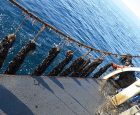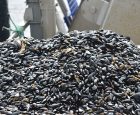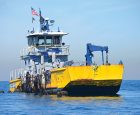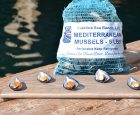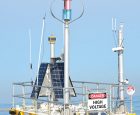
Catalina Sea Ranch: A case study in persistence
July 10, 2019
By
Liza Mayer
CEO Phil Cruver faced numerous challenges during the early years he was trying to get Catalina Sea Ranch (CSR) off the ground. The odds were stacked against it. For instance, the mussel farm was ready to market its first harvest in June 2017 but the lack of FDA-certified biotoxin testing labs in California prevented that harvest from reaching the market .
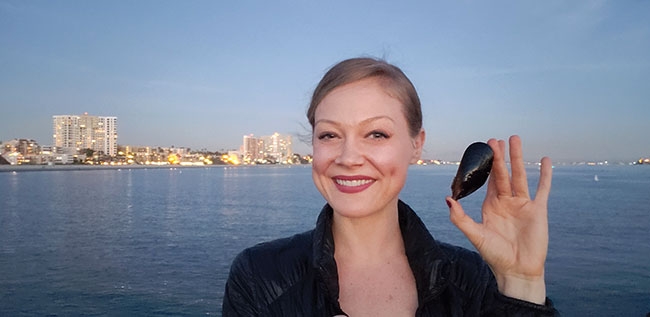 ‘This is really the only chance that we have and putting a dent sustainably in the $15-billion seafood trade deficit in the US Gold mine or money pit?
‘This is really the only chance that we have and putting a dent sustainably in the $15-billion seafood trade deficit in the US Gold mine or money pit?As the first offshore shellfish farm permitted in US federal waters, the 100-acre “ranch,” located about six miles off the coast of Huntington Beach, CA, had to traverse a new landscape. Offshore aquaculture, as an emerging sector, is fraught with uncertainty. There’s a myriad of regulatory challenges that accompany it and potential conflicts with other user groups such as fisheries or tourism, and anti-aquaculture activists.
Lindsay Cruver, head of R & D and the CEO’s daughter, recalls the early days of the eight-year-old company. “Offshore aquaculture has never been done before in the United States and, legally, it’s completely different than farming in state waters. So we were the ones who had to put the painstaking effort of learning how to coordinate with all these new regulatory agencies and also dealing with the opposition of installing the first offshore aquaculture facility,” she said.
Among the user groups opposed to the farm were the state’s $70-million squid fishery and $1-billion recreational fishery. “They did put up a fight initially, but we were able to prove that they don’t fish in our particular area,” she said of the squid fishers. Conflict with the other group has also been overcome as the farm has actually attracted marine life and enhanced recreational fishery.
“There was really nothing out there when we started on the San Pedro shelf, it’s all sandy bottom and pelagic fish coming through. But now that we have a permanent structure out there with mussels growing, we’re finding some fish are becoming permanent residents so Catalina Sea Ranch is now the hottest new fishing spot in southern California and we get a lot of support from the recreational fishery,” Cruver explained.
The nascent sector also requires huge R & D effort and costly technology that would help minimize and monitor environmental impact. At Catalina Sea Ranch, the latter came in the form of an environmental monitoring tool called NOMAD, short for Navy Oceanographic Meteorological Automatic Device. The boat-shaped NOMAD buoys, supplied by the National Oceanic and Atmospheric Administration (NOAA) gather and transmit bathymetric data such as water temperature, salinity, and pH, as well as vital phytoplankton density. They are also equipped with a radar system to provide ranch security, and underwater acoustic cameras to detect seals and sea lions.
The decision to grow mussels as its cash crop instead of the more popular oysters also presented challenges, but growing interest in “impact investing” has put the farm in investors’ radar. “Not that many people wanted to invest in a mussel farm because mussels are seen as mostly bait rather than food. They don’t really have the cachet that oysters do,” said Cruver. To illustrate the point, she said Americans eat only 0.15 lbs of mussels per capita, a dismal figure compared to 5 lbs and 33 lbs per capita in Europe and New Zealand, respectively.
“We started with mussels because they’re easy to grow and they’re profitable. But back in 2012, raising money for a mussel farm was nearly impossible. However, there is a rising trend in recent years called ‘impact investment’. And these investors are very excited about the possibility of investing in not only sustainable but, also, regenerative crops,” she said. The farm also received R & D grants from agencies such as NOAA, the USDA and the US Department of Energy in later years.
Regulatory challenges were par for the course in any new sector, Cruver acknowledged. “The regulatory agencies are just doing their job and they want to be cautious and make sure that our ranch has no negative impact in the surrounding environment,” she said.
The aforementioned lack of FDA-approved biotoxin testing labs to test shellfish safety was a huge setback, but it was resolved a year later. Cruver noted that the State Department of Health is typically the authority for testing shellfish safety but in federal waters, the Food and Drug Administration (FDA), a federal agency, is in charge. “Because we’re a new entity in federal waters, there was no lab approved by the FDA that we could use in California or nearby. It took us a year, but we were able finally able to find a lab that was able to cooperate with us with the FDA certification and could work with our requirements. That allowed us to start selling.”
That lab, located in Washington State, now tests the farm’s mussels before they’re shipped off to the market. “We are now selling our mussels to the local Southern California market and things are going really well,” she says.
They did it, and so can you
The expansion of an onshore processing facility is in the works at the farm to allow it to boost its production from the current “several thousand pounds” to reach the 2-million-pound capacity the farm is designed for. But a more ambitious plan is forthcoming; the farm is waiting for permits to expand by another 2,900 acres to allow for an additional 1,000 acres for mussels, 1,000 acres for seaweed, and the rest for cage culture of other crops, such as purple hinge, rock scallops, triploid Pacific oysters and kelp, that it currently farms in small quantities.
CEO Phil Cruver clearly did not let the abundant challenges stand in the way of his ambition to build the ranch. Its success could help change people’s views of aquaculture and pave the way for other players.
“We’ve taken a lot of arrows for the offshore aquaculture industry. And this is really the only chance that we have and putting a dent sustainably in the $15-billion seafood trade deficit in the United States,” says the younger Cruver.

